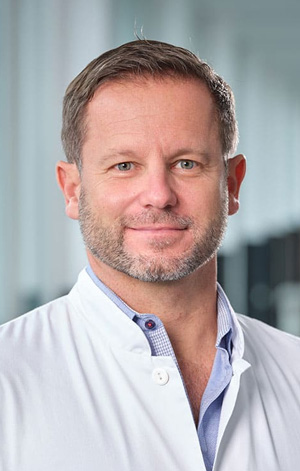Neurovascular compression syndrome
Trigeminal neuralgia
Trigeminal neuralgia (TGN) is a shooting pain in the distribution area of one or more branches of the sensory facial nerve (trigeminal nerve). According to the current classification of the International Headache Society (IHS), two forms of TGN can be differentiated. The differentiation is therapeutic in terms of the timing, and the selection of invasive treatment methods is of great importance.
Classic (or idiopathic) TGN is usually triggered by vascular compression of the trigeminal nerve through the superior cerebellar artery. The symptoms usually occur after the age of 50. In women, the incidence is 5.9/100,000/year. In men, it is 3.9/100,000/year. Most frequently, the second and third trigeminal branch are affected alone (18% and 15%) or in combination (40%).
Symptomatic TGN is caused by lesions or demyelinating diseases such as multiple sclerosis. Lesions in the brain stem (e.g. cavernomas) cause irritation of the cranial nerve nuclei. Other lesions such as acoustic neuromas and meningiomas can cause direct nerve relocation. It usually emerges before the age of 40. It is frequently accompanies by attack of the first trigeminal branch as well as bilateral nerve pain.
Special techniques implemented at our centre
Using the ablative method, the trigeminal nerve is thermally, chemically, or mechanically damaged. However, in our practice, we do not use destructive procedures but rather function-preserving procedures such as endoscopic microvascular decompression. Here, the neurovascular conflict is resolved through microsurgery and a curative solution is sought. Using a purely endoscopic technique, the trigeminal nerve is exposed via a tiny keyhole slot behind the ear. At the nerve entry zone, of neurovascular conflict is identified with the help of neuronavigation. The compressing vessel is then detached from the nerve. By inserting a small piece of Teflon, the nerve is then padded from the vessel. The functions of the brain stem and basal cranial nerves are continuously monitored using electrophysiological techniques.
By applying navigation-assisted, minimally-invasive endoscopic methods, we have been able to achieve a high rate of success in recent years. The main advantage of endoscopy: the point of the conflict is depicted particularly well and the decompression can be reliably assessed. The rate of recurrence is rather low; in more than 90–95% of cases, it can be considered a definitive cure.
Hemifacial spasm
A hemifacial spasm is a sudden involuntary unilateral tonic-clonic spasm of the facial muscles. The spasms generally only last seconds to minutes. However, in severe cases, they can be permanent. The cause is a pulsating compression of the motor facial nerve (facial nerve) by a vascular loop – usually by the anterior inferior cerebellar artery. The constant pulsations cause injury to the nerve root, thereby leading to spontaneous discharges which trigger the spasms.
Special techniques implemented at our centre
At our centre, the operation is performed using a navigation-guided, endoscopically-assisted micro-surgical technique. The facial nerve is exposed through a tiny keyhole slot of the skull behind the ear. The compressing vessel is then detached from the nerve root and held away with a small piece of Teflon. The padding step is always monitored using an endoscope. The functions of the brain stem and the nerves affected are continually tested by neuro-monitoring. Microvascular decompression is a causal treatment; the cause of the disease is resolved. Owing to the use of the navigation-assisted endoscopic methods, a particularly high success rate (up to 85% freedom from symptoms) has been reported. At our centre, we have achieved a 100% success rate in the past five years.
Glossopharyngeal neuralgia
Compared with trigeminal neuralgia, glossopharyngeal neuralgia is far less frequent. It is characterised by paroxysmal unilateral pain at the base of the tongue and posterior pharynx. The elderly are primarily affected. The disease is uniformly distributed over the sexes. In recent years, an incidence of 0.2–0.7/100,000/year has been reported.
The disease is often caused by a conflict between a vascular loop and the glossopharyngeal nerve (the ninth cranial nerve). The cause is occasionally a tumour in the region of the brain stem. In some cases, no explanatory pathology can be found. In some patients, the disease occurs in combination with a trigeminal neuralgia.
Special techniques implemented at our centre
At our centre, the operation is performed using a navigation-guided, endoscopically-assisted micro-surgical technique. The glossopharyngeal nerve is exposed through a tiny keyhole slot of the skull behind the ear. The compressing vessel is then detached from the nerve root and held away with a small piece of Teflon. The padding step is always controlled by the endoscope. Functions of the brain stem and the affected nerve are continually checked via neuromonitoring. Microvascular decompression is a causal treatment; the cause of the disease is resolved. If the correct indication is given, the success rate of the operation is high. There is relatively low stress for the patient and the risk is reasonable.
